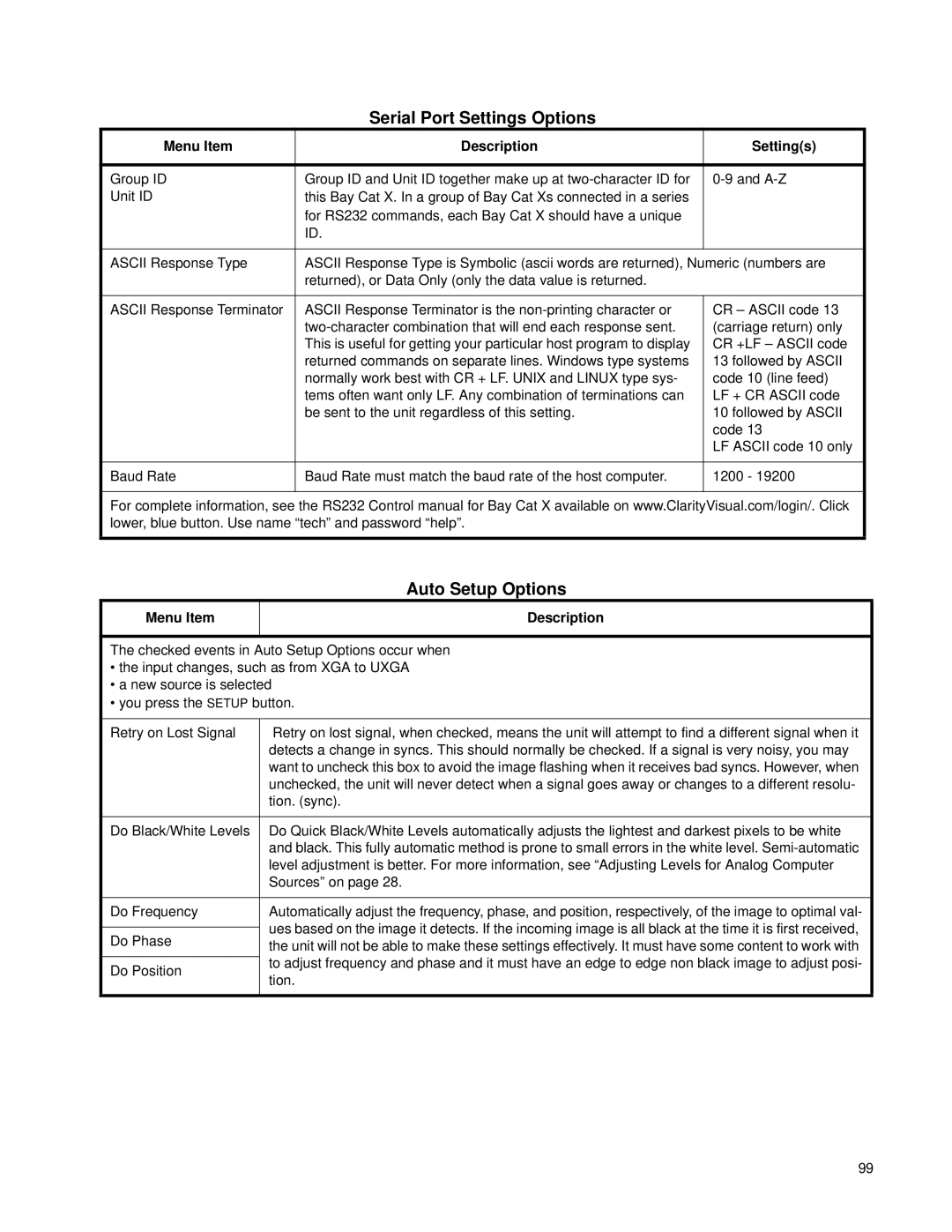
Serial Port Settings Options
Menu Item | Description | Setting(s) |
|
|
|
Group ID | Group ID and Unit ID together make up at | |
Unit ID | this Bay Cat X. In a group of Bay Cat Xs connected in a series |
|
| for RS232 commands, each Bay Cat X should have a unique |
|
| ID. |
|
|
|
|
ASCII Response Type | ASCII Response Type is Symbolic (ascii words are returned), Numeric (numbers are | |
| returned), or Data Only (only the data value is returned. |
|
|
|
|
ASCII Response Terminator | ASCII Response Terminator is the | CR – ASCII code 13 |
| (carriage return) only | |
| This is useful for getting your particular host program to display | CR +LF – ASCII code |
| returned commands on separate lines. Windows type systems | 13 followed by ASCII |
| normally work best with CR + LF. UNIX and LINUX type sys- | code 10 (line feed) |
| tems often want only LF. Any combination of terminations can | LF + CR ASCII code |
| be sent to the unit regardless of this setting. | 10 followed by ASCII |
|
| code 13 |
|
| LF ASCII code 10 only |
|
|
|
Baud Rate | Baud Rate must match the baud rate of the host computer. | 1200 - 19200 |
|
|
|
For complete information, see the RS232 Control manual for Bay Cat X available on www.ClarityVisual.com/login/. Click lower, blue button. Use name “tech” and password “help”.
| Auto Setup Options |
Menu Item | Description |
|
|
The checked events in Auto Setup Options occur when
• the input changes, such as from XGA to UXGA
• a new source is selected
• you press the SETUP button.
Retry on Lost Signal | Retry on lost signal, when checked, means the unit will attempt to find a different signal when it | |
| detects a change in syncs. This should normally be checked. If a signal is very noisy, you may | |
| want to uncheck this box to avoid the image flashing when it receives bad syncs. However, when | |
| unchecked, the unit will never detect when a signal goes away or changes to a different resolu- | |
| tion. (sync). | |
|
| |
Do Black/White Levels | Do Quick Black/White Levels automatically adjusts the lightest and darkest pixels to be white | |
| and black. This fully automatic method is prone to small errors in the white level. | |
| level adjustment is better. For more information, see “Adjusting Levels for Analog Computer | |
| Sources” on page 28. | |
|
| |
Do Frequency | Automatically adjust the frequency, phase, and position, respectively, of the image to optimal val- | |
| ues based on the image it detects. If the incoming image is all black at the time it is first received, | |
Do Phase | ||
the unit will not be able to make these settings effectively. It must have some content to work with | ||
| to adjust frequency and phase and it must have an edge to edge non black image to adjust posi- | |
Do Position | ||
tion. | ||
| ||
|
|
99
